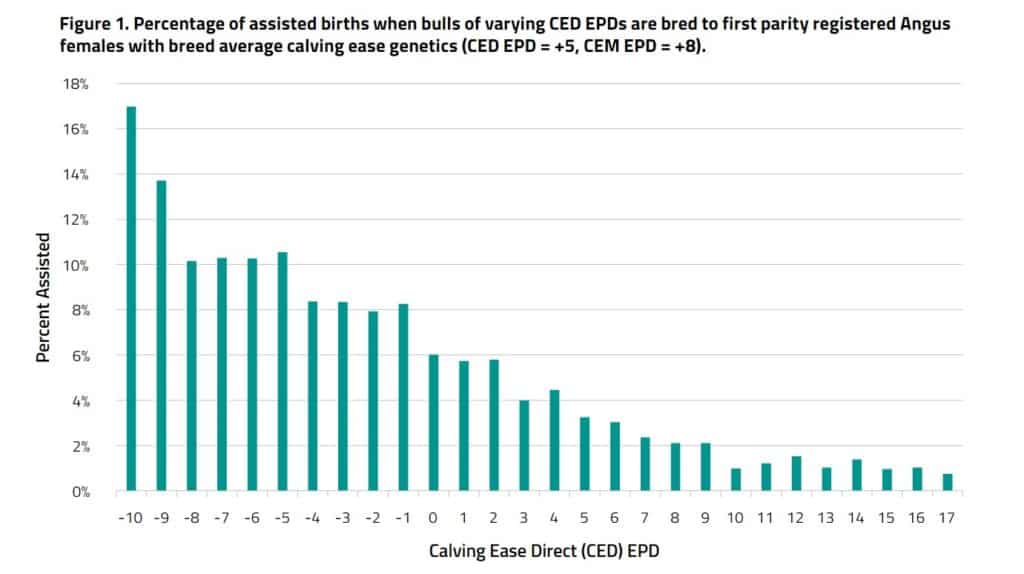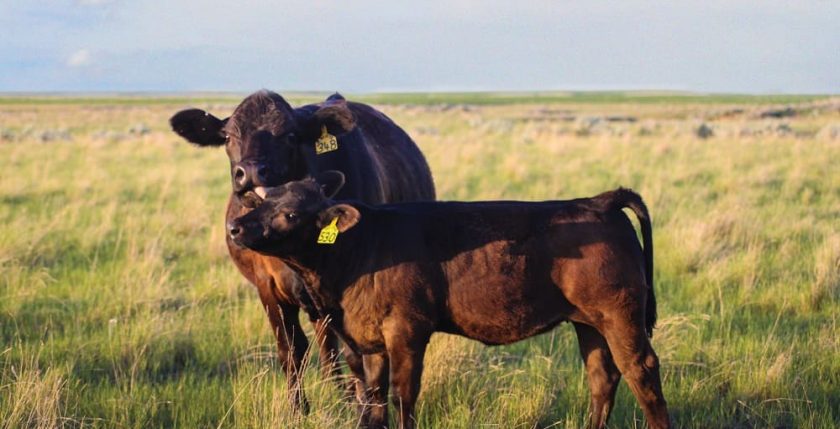Calving ease is a desired trait. Most would argue it is not only desired but necessary, as calving difficulty can lower calf survivability and extend post-partum intervals for cows, which then lowers breed-back rates. Expected Progeny Differences (EPDs) can be utilized to help manage this risk. Kelli Retallick, Genetic Service Director for Angus Genetics Inc. discusses this topic further.
Often, producers ask, “Can we have too much calving ease?” To answer, it is important to reflect on the basis of the calving ease argument, the build of the EPD and what to expect when using these tools. Knowing this, cow/calf producers – both seedstock and commercial alike – can make informed decisions about their own herds.
Using the tool
Calving Ease Direct, or CED, is the most effective tool when deciding which bulls to mate to first-calf heifers. Expressed as a probability percentage, CED aims to predict the percentage of unassisted births a bull will produce when mated to heifers.
Let’s compare two bulls. Bull A has a CED EPD of +2, and bull B has a CED EPD of +7. When mating these two bulls to similar groups of heifers, phenotypically and genetically, one would expect, on average, bull B to produce 5% more unassisted births than bull A. While no one can indefinitely state the perfect cut‑off to be used across the industry, producers can rely on the information available to them to make the best decisions. It gets even simpler when producers can rely on past records to benchmark the amount of calving difficulty experienced to understand where selection pressure should be placed.
Behind the EPD
Calving ease scores collected by breeders are utilized to predict CED. These scores range from 1-5, where 1 would indicate a birth with no assistance. For Angus cattle, only scores reported on first-calf heifers are used in the prediction of the CED EPD. Mature female scores, while they can be reported, are not used in the national cattle evaluation as not enough variation, or differences among reported scores, exists to add value to CED predictions.
Birth weight is used as a correlated trait in the calving ease evaluation. The correlation, or strength of relationship, between calving ease and birth weight is -0.65 which is a moderately strong, negative relationship. A negative correlation suggests as one trait goes up the other goes down. Therefore, in most cases, as calving ease increases, birth weight tends to trend downward. When focusing on decreasing calving difficulty in first-calf heifers, it is most effective to focus on CED EPDs as this is the economically relevant trait. On the other hand, if the focus is to strictly increase or decrease birth weight, the BW EPD is the tool of choice and most effective to influence changes on actual birth weights of calves.
These scores and weights are then evaluated together in a threshold model, but it is important to understand in a threshold model an underlying assumption is made about the amount of existing calving difficulty. Therefore, if the tool is predicting the decreased number of assisted births in a population, a percentage of assisted births is assumed. In the case of the Angus CED EPD, this threshold model was designed to help lower the level of assisted births present in a mixed breed commercial cowherd, which in most cases would have a higher incidence of calving difficulty than a purebred registered Angus herd. This is why patterns in the data representing the percentage of assisted and unassisted births of the purebred Angus herd are not always completely linear when tracking up or down the CED scale.
Figure 1 breaks out the percentage of assisted births recorded for each CED EPD possessed by the sire when bred to a breed average Angus female. As the CED EPD of the sire increases, the number of assisted births decreases. However, the decrease may not be by an entire percentage point as expected. The reason? Mating Angus sires to Angus females who are breed average for both calving ease direct and maternal is not the expected industry average mating.

In a recent survey conducted by the American Angus Association, producers reported treating calving ease as a completely separate trait using independent culling levels when making genetic decisions. Independent culling is a selection strategy stating an individual animal will be culled if it does not meet the specific requirement of a single trait, regardless of the levels of other traits. Using this method of independent culling, while efficient in making genetic change in that specific trait, can lead to drawbacks which can affect herds in the long term. Producers setting specific thresholds on any trait, ignoring a multi-trait approach, can lead to eliminating bulls for falling just under this culling threshold even though they may possess other characteristics valuable to the operation.
Conclusion
The bottom line – not all cowherds are created equal. What can be utilized safely in one herd may cause problems in another. Knowing CED is designed to be a heifer mating tool, using different bulls to mate first-calf heifers and mature cows may be logical. The best advice may be to understand the cowherd these bulls will be utilized in.
As a cattle producer, you know your cowherd better than anyone. If the bulls used on first-calf heifers have averaged a +6 for the CED EPD for several years and you have yet to pull a calf, then a +6 CED bull is a safe option. On the other hand, if your bulls have averaged +10 CED and you have repeatedly pulled a higher percentage of calves from first-calf heifers than desired, then more calving ease may be necessary. Understanding the relationships in your herd is crucial to the overall success of the genetic program.


